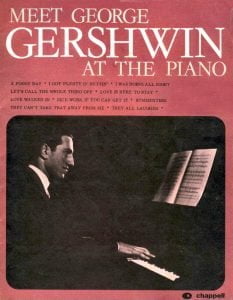George Gershwin at the piano – The man I love (with sheet music)
George Gershwin (born Jacob Bruskin Gershowitz, September 26, 1898 – July 11, 1937) was an American composer and pianist whose compositions spanned both popular and classical genres. Among his best-known works are the orchestral compositions Rhapsody in Blue (1924) and An American in Paris (1928), the songs Swanee (1919) and Fascinating Rhythm (1924), the jazz standard I Got Rhythm (1930), and the opera Porgy and Bess (1935) which spawned the hit Summertime.

Gershwin studied piano under Charles Hambitzer and composition with Rubin Goldmark, Henry Cowell, and Joseph Brody. He began his career as a song plugger but soon started composing Broadway theater works with his brother Ira Gershwin and with Buddy DeSylva. He moved to Paris intending to study with Nadia Boulanger, but she refused him. He subsequently composed An American in Paris, returned to New York City and wrote Porgy and Bess with Ira and DuBose Heyward. Initially a commercial failure, it came to be considered one of the most important American operas of the twentieth century and an American cultural classic.
Gershwin moved to Hollywood and composed numerous film scores. He died in 1937 of a malignant brain tumor. His compositions have been adapted for use in film and television, with several becoming jazz standards recorded and covered in many variations.
Browse in the Library:
and subscribe to our social channels for news and music updates:
Musical analysis
Background
• 1924
• Taken from Lady, Be Good
• Lyrics by Ira Gershwin
• From first really successful show
• Style shows move forward from Tin Pan Alley
• Slow song
• Yearning for love
• Began as verse to another song, but Ira suggested changing it to a chorus
Melody
• Sequence used in melody
• Melodic climax reached
• Use of blue notes in melody
• Narrow tessitura
• Conjunct melodic line
Rhythm
• Rhythm of lyrics reflected in rhythm of melody
• Tempo change shows change in mood
Timbre
• Piano word painting
Texture
• Melody dominated homophony
• R.H. of piano doubles vocal line
Harmony
• Verse 1 is in Eb
• Verse 2 in Bb then returns to home key
• Chromaticism
Structure
• Short verse
• 8 lines
• Chorus of twice the length
• AABA
Lyrics
• Verse is reflective
• Hope filled chorus
• Some sense Ira Gershwin is forcing lyrics to fit
